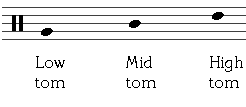Percussion Lesson: Beginner Drum Lesson Part 1
If you're wanting your first lesson in how to play drums, you've come to the right place!
By the end of this 2-part lesson, you'll be playing your first simple rock beat, so let's get straight into it, beginning with a few technicalities.
The Staff
Drum music, like most other music is written on 5 lines known as the staff, or stave. Each instrument in the kit has its own place on the staff. At the beginning of the staff is a sign called a clef which looks like this :

This tells us the notes on the staff are notes for percussion, as opposed to any other instrument.
The Drums
The snare and the bass drums sit in the spaces in between the lines.

While the three toms each sit on a separate line:

The Cymbals
Finally, the cymbals are shown with crosses as follows (N.B. there are several different ways of notating cymbals - you may find them written differently elsewhere).

Rhythm
The next thing we need to understand before we get down to some playing is how to read the rhythm.
The length of a note is measured by counting.
A quarter-note (or crotchet in the UK) lasts for 1 count and looks like this:
so five quarter-notes on the snare drum in a row will look like this :
A half-note (or minim in the UK) lasts for 2 counts and looks like this:
so four half-notes on the snare drum will look like this :
Click on the play button to hear the half-notes played on snare, together with a background tick for the counts (there are 4 counts introduction before the snare starts).
Finally, a whole note (or semibreve) lasts for 4 counts and looks like this:
so four whole notes on the snare drum in a row will look like this :
(Again, there are 4 counts introduction before the snare starts).
Bars
Music is grouped into groups of counts known as bars. The first type of bar we will see is 4/4, written :

which means there are 4 quarter-note counts in each bar. Below is an example of two bars written in 4/4 time. The first bar contains 4 quarter-notes, each lasting for one count. The second bar contains a whole note which lasts for 4 counts, and so, occupies the entire bar.

The groups of 4 counts are separated by vertical lines known as bar-lines. A double bar-line signifies the end of a piece.



